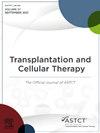Allogeneic Stem Cell Transplantation in Participants With Hematologic Malignancies Following Pembrolizumab Therapy
IF 4.4
3区 医学
Q2 HEMATOLOGY
引用次数: 0
Abstract
The safety and efficacy of allogeneic stem cell transplantation (allo-SCT) following antiprogrammed cell death protein 1 (PD-1) therapy in participants with hematologic malignances is of high clinical interest. The objective of the study is to present outcomes in participants enrolled in 4 clinical trials who underwent allo-SCT within 2 years of their last dose of pembrolizumab therapy. This analysis included participants from the phase 1b KEYNOTE-013 study (n = 20), the phase 2 KEYNOTE-087 study (n = 31), the phase 2 KEYNOTE-170 study (n = 5), and the phase 3 KEYNOTE-204 study (n = 14). Outcomes of interest included acute and chronic graft-versus-host disease (GVHD), progression-free survival (PFS) and overall survival (OS), transplant-related mortality (TRM), and relapse. Of 70 participants included in the analysis, 57 had classical Hodgkin lymphoma (cHL) and the remainder had B-cell non-Hodgkin lymphoma, multiple myeloma, and myelodysplastic syndrome. Overall, 31 participants (44%) were in remission at first allo-SCT. The median duration of treatment with pembrolizumab was 5.3 months (range, 0.7 to 29.6), and the median time from last dose of pembrolizumab to allo-SCT was 4.6 months (range, 1 to 20). The estimated 6-month cumulative incidence of grade II-IV acute GVHD was 41% (95% confidence interval [CI], 30% to 53%); the estimated 6-month cumulative incidence of grade III-IV acute GVHD was 20% (95% CI, 12% to 30%). The estimated 1-year incidence of chronic GVHD was 19% (95% CI, 11% to 29%). After a median follow-up of 40.1 months, both the estimated median PFS and median OS after allo-SCT were not reached; the 40-month PFS rate was 56.8% and the 40-month OS rate was 76.5%. The estimated 40-month cumulative incidence of TRM and relapse was 17% (95% CI, 9% to 27%) and 27% (95% CI, 16% to 38%), respectively. Among participants with cHL (median follow-up, 39.5 months), both the estimated median PFS and median OS after allo-SCT were not reached; the 40-month PFS rate was 59.7% and the 40-month OS rate was 83.4%. The estimated 40-month cumulative incidence of TRM and relapse in participants with cHL was 12% (95% CI, 5% to 23%) and 23% (95% CI, 12% to 36%), respectively. Overall, the incidences of acute and chronic GVHD in this cohort were within the expected ranges. PFS and OS outcomes were favorable, and the rates of TRM and relapse were low. These results support allo-SCT as a useful and feasible salvage option after anti–PD-1 therapy.
接受 Pembrolizumab 治疗的血液恶性肿瘤患者的异基因干细胞移植。
背景:同种异体干细胞移植(allo-SCT)在抗程序性细胞死亡蛋白1 (PD-1)治疗后对血液恶性肿瘤患者的安全性和有效性具有很高的临床意义。目的:介绍在最后一次派姆单抗治疗后2年内接受同种异体细胞移植的4项临床试验参与者的结果。研究设计:本分析包括1b期KEYNOTE-013研究(n = 20)、2期KEYNOTE-087研究(n = 31)、2期KEYNOTE-170研究(n = 5)和3期KEYNOTE-204研究(n = 14)的参与者。研究结果包括急性和慢性移植物抗宿主病(GVHD)、无进展生存期(PFS)和总生存期(OS)、移植相关死亡率(TRM)和复发。结果:在纳入分析的70名参与者中,57名患有经典霍奇金淋巴瘤(cHL),其余为b细胞非霍奇金淋巴瘤、多发性骨髓瘤和骨髓增生异常综合征。总体而言,31名参与者(44%)在首次移植时缓解。派姆单抗治疗的中位持续时间为5.3个月(范围,0.7至29.6),从最后一次给药派姆单抗到allo-SCT的中位时间为4.6个月(范围,1至20)。估计6个月II-IV级急性GVHD的累积发病率为41%(95%可信区间[CI], 30%至53%);估计6个月III-IV级急性GVHD的累积发生率为20% (95% CI, 12% - 30%)。估计1年慢性GVHD发病率为19% (95% CI, 11%至29%)。在中位随访40.1个月后,allo-SCT后的估计中位PFS和中位OS均未达到;40个月PFS率为56.8%,40个月OS率为76.5%。估计40个月的TRM和复发率分别为17% (95% CI, 9%至27%)和27% (95% CI, 16%至38%)。在cHL患者中(中位随访39.5个月),allo-SCT后的估计中位PFS和中位OS均未达到;40个月PFS率为59.7%,40个月OS率为83%。cHL患者40个月累积TRM和复发的估计发生率分别为12% (95% CI, 5% - 23%)和23% (95% CI, 12% - 36%)。结论:总体而言,该队列中急性和慢性GVHD的发病率在预期范围内。PFS和OS结果良好,TRM和复发率低。这些结果支持同种异体细胞移植作为抗pd -1治疗后有用和可行的挽救选择。
本文章由计算机程序翻译,如有差异,请以英文原文为准。
求助全文
约1分钟内获得全文
求助全文
来源期刊

Transplantation and Cellular Therapy
Medicine-Hematology
CiteScore
7.00
自引率
15.60%
发文量
1061
审稿时长
51 days
 求助内容:
求助内容: 应助结果提醒方式:
应助结果提醒方式:


